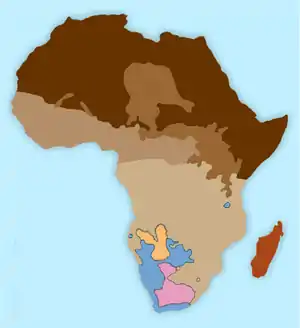Tuu languages
The Tuu languages, or Taa–ǃKwi (Taa–ǃUi, ǃUi–Taa, Kwi) languages, are a language family consisting of two language clusters spoken in Botswana and South Africa. The relationship between the two clusters is not doubted but is not close. The name Tuu comes from a word for "person" common to both branches of the family.
| Tuu | |
|---|---|
| ǃUi–Taa Southern Khoisan (obsolete) | |
| Geographic distribution | South Africa and Botswana |
| Linguistic classification | One of the world's primary language families (formerly considered Khoisan) |
| Subdivisions |
|
| Glottolog | tuuu1241 |
 Tuu languages in pink | |
Classification
The Tuu languages are not demonstrably related to any other language family, however they do share a great many similarities to the languages of the Kxʼa family. This is generally thought to be due to thousands of years of contact and mutual influence (that is, a sprachbund), but some scholars believe that the two families may eventually prove to be related.
The Tuu languages were once thought to form a branch of the now-obsolete Khoisan language family and were called Southern Khoisan in that scenario.
Languages
- Taa
- ǃXóõ (a dialect cluster)
- Lower Nossob (two dialects, ǀʼAuni and Kuǀhaasi) †
- ǃKwi (ǃUi)
The ǃKwi (ǃUi) branch of South Africa is moribund, with only one language remaining, Nǁng, and that with less than 5 elderly speakers. ǃKwi languages were once widespread across South Africa; the most famous, ǀXam, was the source of the modern national motto of that nation, ǃke eː ǀxarra ǁke.
The Taa branch of Botswana is more robust, though it also has one surviving language, ǃXóõ, with 2,500 speakers.
Because many of the Tuu languages became extinct with little record, there is considerable confusion as to which of their many names represented separate languages or even dialects. See List of Khoisan languages for some possibilities.
The Tuu languages, along with neighbouring ǂʼAmkoe, are known for being the only languages in the world to have bilabial clicks as distinctive speech sounds (apart from the extinct ritual jargon Damin of northern Australia, which was never anyone's mother tongue). Taa, ǂʼAmkoe and neighbouring Gǀui (of the Khoe family) form a sprachbund (language area) with some of the most complex inventories of both consonants and vowels in the world. All languages in these three families also have tone.
References
Sources
- Güldemann, Tom. (2006). "The San languages of southern Namibia: Linguistic appraisal with special reference to J. G. Krönlein's Nǀuusaa data." Anthropological Linguistics, 48(4): 369–395.
- Story, Robert. (1999). "Kʼuǀha꞉si Manuscript" (MS collections of the Kiǀhazi dialect of Bushman, 1937). Khoisan Forum Working Paper 13. ed. Anthony Traill. Köln: University of Köln. 18–34.